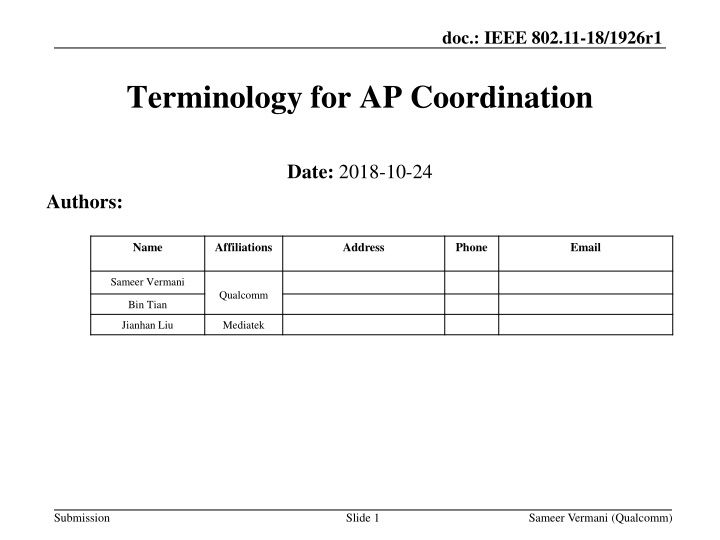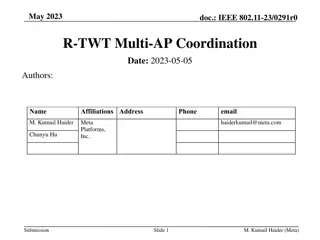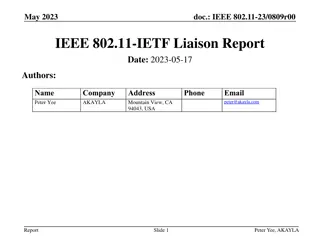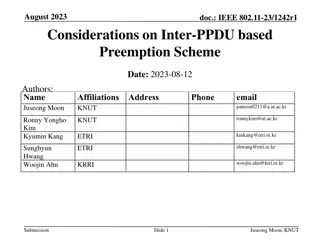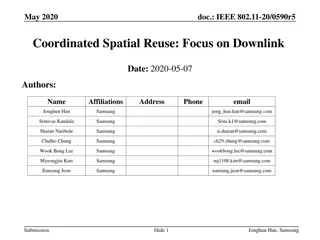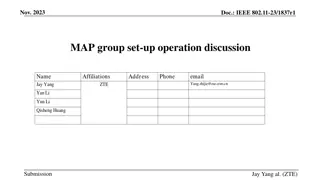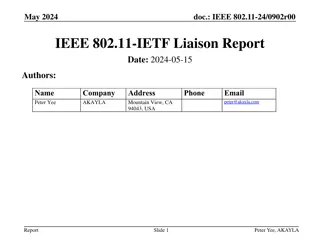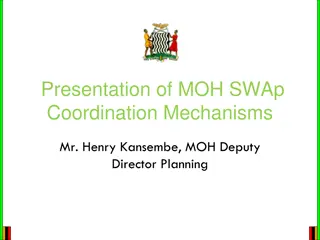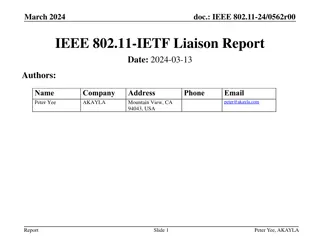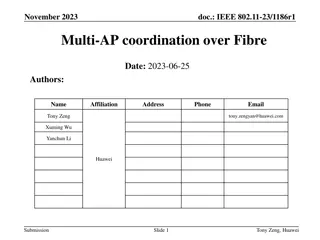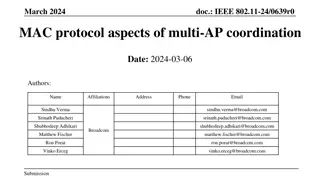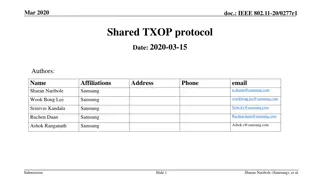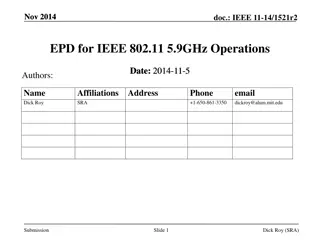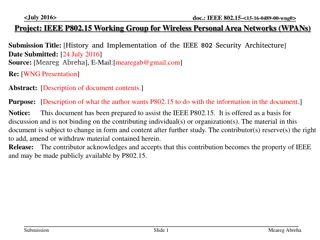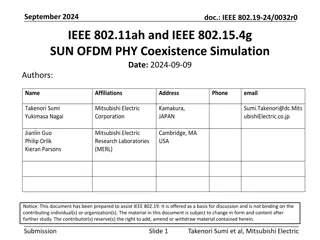IEEE 802.11-18/1926r1: AP Coordination Terminology Simplified
These slides aim to clarify the terminology surrounding AP coordination in the context of the EHT standard. They explore different levels of AP coordination complexity and offer a common language for key modes discussed. High-level bifurcation of AP coordination schemes and techniques are presented, including Coordinated and Joint approaches for transmitting data to users. Examples of Coordinated Beamforming and Coordinated OFDMA techniques are illustrated to demonstrate efficient utilization of frequency resources.
Download Presentation

Please find below an Image/Link to download the presentation.
The content on the website is provided AS IS for your information and personal use only. It may not be sold, licensed, or shared on other websites without obtaining consent from the author.If you encounter any issues during the download, it is possible that the publisher has removed the file from their server.
You are allowed to download the files provided on this website for personal or commercial use, subject to the condition that they are used lawfully. All files are the property of their respective owners.
The content on the website is provided AS IS for your information and personal use only. It may not be sold, licensed, or shared on other websites without obtaining consent from the author.
E N D
Presentation Transcript
doc.: IEEE 802.11-18/1926r1 Terminology for AP Coordination Date: 2018-10-24 Authors: Name Affiliations Address Phone Email Sameer Vermani Qualcomm Bin Tian Jianhan Liu Mediatek Submission Slide 1 Sameer Vermani (Qualcomm)
doc.: IEEE 802.11-18/1926r1 Abstract AP coordination has been discussed as a possible technology to be adopted in the EHT standard Different levels of AP coordination are possible [1] Each comes with a different level of implementation complexity The purpose of these slides is to clarify the terminology of the AP coordination area further An attempt to develop a common language for the key modes discussed so far Slides not meant to serve as an exhaustive list of AP coordination modes Submission Slide 2 Sameer Vermani (Qualcomm)
doc.: IEEE 802.11-18/1926r1 Terminology Basics High level bifurcation of various AP coordination schemes 1. Techniques where data of one user is sent from a single AP 2. Techniques where data of one user is sent from multipleAPs Techniques of type 1. use the term Coordinated in their names Multiple APs are doing one (or both) of the following: a) Transmitting on the same frequency resource: Coordinating and forming spatial nulls to allow for simultaneous transmissions from multiple APs b) Transmitting on orthogonal frequency resources: Coordinating and splitting the spectrum to utilize it more efficiently Techniques of type 2. use the term Joint in their names [2] Multiple APs are transmitting jointly to a given user Submission Slide 3 Sameer Vermani (Qualcomm)
doc.: IEEE 802.11-18/1926r1 Technique 1a : Coordinated BF Solid blue lines are data transmissions to in-BSS STAs, dotted red lines are steered nulls to OBSS STAs Key attribute: Signal for a user is only transmitted from one AP while forming nulls to OBSS STAs AP2 AP1 BSS2 BSS1 Submission Slide 4 Sameer Vermani (Qualcomm)
doc.: IEEE 802.11-18/1926r1 Technique 1b : Coordinated OFDMA Extend 11ax OFDMA from single BSS to multi-BSS scenarios Leads to efficient utilization of frequency resources across the network Increases efficiency when in-BSS traffic is not utilizing the resources fully 20MHz STA 1, 2, 3 40 MHz 20MHz STA 4, 5 Blue color spectrum being used by transmissions in BSS1 Green color spectrum being used by transmissions in BSS2 Synchronized transmissions to achieve orthogonality Submission Slide 5 Sameer Vermani (Qualcomm)
doc.: IEEE 802.11-18/1926r1 Technique 2 : Joint Processing Transmissions Solid blue lines are data transmissions Key attribute: Signal for a user is transmitted from multiple APs Data of all participating STAs needs to be available at all APs MU-MIMO using one giant precoder over the combined array consisting of the Tx antennas of all APs AP2 AP1 BSS2 BSS1 Submission Slide 6 Sameer Vermani (Qualcomm)
doc.: IEEE 802.11-18/1926r1 Special Case of Joint Processing Transmissions: Joint Beamforming to a Single STA This technique needs to be looked at separately as it might have less stringent synchronization requirements Easier than the Joint Processing Transmissions to multiple STAs Exploit beamforming and power gain from multiple APs AP2 AP1 Single STA being served by multiple APs Submission Slide 7 Sameer Vermani (Qualcomm)
doc.: IEEE 802.11-18/1926r1 Generalization of Terminology Joint processing transmission or coordinated BF may happen on part of the PPDU bandwidth Need a name for the general transmissions where multiple APs are transmitting at the same time Regardless of the level of coordination in different parts of the spectrum Suggest the name Distributed MU for such PPDUs An extension of the 11ax MU PPDU terminology Submission Slide 8 Sameer Vermani (Qualcomm)
doc.: IEEE 802.11-18/1926r1 Summary of Terminology on AP Coordination Joint Processing Techniques Coordinated Techniques Coordinated Beamforming Coordinated OFDMA Joint Processing Transmissions Special case: Joint Beamforming to a single STA Note: Above is not an exhaustive list of all AP coordination schemes Submission Slide 9 Sameer Vermani (Qualcomm)
doc.: IEEE 802.11-18/1926r1 References [1] Jianhan Liu et al, Discussions on Multi-AP Coordination , IEEE document 11-18/1509r0. [2] R. Irmer, et. al., Coordinated Multipoint: Concepts, Performance and Field Trials, IEEE Communications Magazine, February 2011. Submission Slide 10 Sameer Vermani (Qualcomm)
